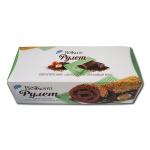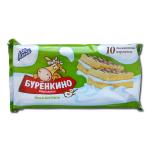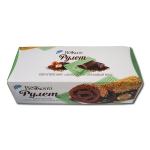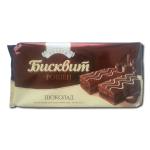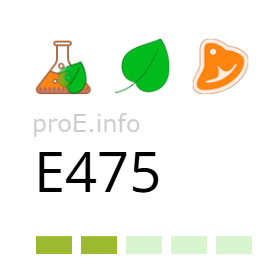
Other names for the additive (synonyms)
General Information
Food additive E475 (polyglycerol esters of fatty acids) is a mixture of complex esters obtained by reacting polyglycerols with edible fats, oils, or free fatty acids. In the food industry, it is used as an emulsifier or stabilizer.
Various fatty acids of plant or animal origin are used in the production of E475. Most commonly, these are palmitic, stearic, oleic, and linoleic acids.
The polyglycerols used for synthesizing emulsifier E475 are polymers of glycerol, predominantly consisting of di-, tri-, and tetraglycerol units. In the final additive, the content of high-molecular polyglycerols (above heptaglycerol) does not exceed 10%.
The general structural formula of polyglycerol esters of fatty acids can be written as HO–[CH₂–CH(OH)–CH₂–O]ₙ–R, where: [CH₂–CH(OH)–CH₂–O]ₙ is a chain of several glycerol residues (polyglycerol), n = 2-10 (mostly di-, tri- or tetraglycerol); R is the fatty acid residue.
The chemical structure of E475 provides good solubility in fats and oils, but poor solubility in water.
During the industrial synthesis of E475 through esterification of polyglycerols with fatty acids, trace amounts of toxic and potentially carcinogenic impurities may be present in the final product, such as epichlorohydrin, glycidol, and others.
Effects on the Body
Benefits of additive E475
In the human body, E475 is hydrolyzed into monoglycerides, diglycerides, polyglycerols, and free fatty acids, which are metabolized similarly to natural fats. Polyglycerols are hardly absorbed and are excreted unchanged. Fatty acids enter metabolic processes or are broken down into carbon dioxide and water by the enzyme lipase.
Additive E475 does not have any confirmed beneficial effects for the human body.
Risks of additive E475
The main potential risk is not from the E475 itself, but from possible impurities formed during production. Specifically, these are toxic and potentially carcinogenic substances such as epichlorohydrin, glycidol, erucic acid, and trans fats. Their amounts in the final product are regulated by safety standards.
According to EFSA (2017) and JECFA (1974), no adverse effects from E475 consumption were identified, even at high doses. Long-term studies in rats showed no toxic effects at intake levels up to 5% in the diet (equivalent to 2.5 g/kg body weight per day). Short-term and subchronic studies also revealed no negative effects at doses up to 9 g/kg body weight.
The genotoxic potential of E475 has not been identified in available studies. Reproductive and embryotoxic effects were also not found, although the existing studies have certain methodological limitations.
In 2017, the EFSA Panel on Food Additives confirmed that additive E475 poses no health risk to humans at current usage levels in the food industry and does not require a numerical ADI (Acceptable Daily Intake).
At the same time, EFSA recommended revising and tightening the EU specifications for E475 to establish stricter maximum limits for toxic impurities such as arsenic, lead, mercury, cadmium, epichlorohydrin, glycidol, trans fats, and 3-MCPD. These recommendations aim to minimize possible contamination of food products with these substances.
Uses
In the food industry, E475 is widely used as an emulsifier, texture stabilizer, and foaming agent. It prevents phase separation and ensures a uniform product texture.
Main applications of E475 include:
- Confectionery (chocolate, fillings, glazes, creams);
- Bakery products (improves dough quality and final product texture);
- Dairy products (cream, yogurts, desserts);
- Ice cream (enhances structure stability during freezing);
- Margarines and spreads;
- Infant and dietetic formulas.
Legal Status
Additive E475 is approved for use in food products in the European Union under Regulation (EC) No 1333/2008 and is included in the list of permitted additives in the United Kingdom. In most countries worldwide, including the USA, Canada, Japan, and Australia, the additive is also approved for use.
